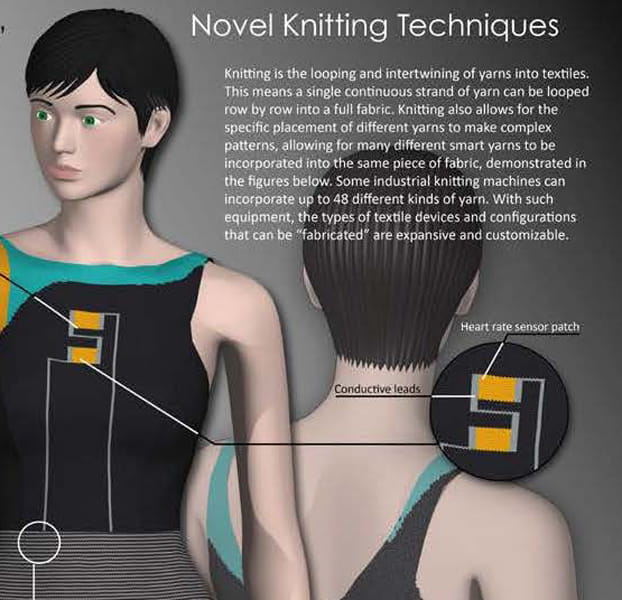How-To Meets High-Tech In Drexel Engineers' Award-Winning Graphic

- Drexel Selects New, World-Class Life Sciences Building at 3201 Cuthbert Street for Medical Research Operations
- Turn Happy Places and Memories into a Happy New Year
- Breakthrough on Gene Therapy for Hereditary Spastic Paraplegia
- Drexel Environmental Collaboratory Releases Cross-Sector Findings on Severe Weather Recovery Challenges

The team of Drexel University engineers who came up with a way to knit an energy storage device have now been recognized by the National Science Foundation for their skill in showing how they did it.
Doctoral students Kristy Jost and Babak Anasori along with Majid Beidaghi, PhD, a postdoctoral research associate, all from the College of Engineering, earned first place in the NSF’s International Science and Engineering Visualization Challenge. Their entry was a poster entitled “Wearable Power,” which depicts their research in turning carbon materials into wearable energy storage devices.
“It was a true challenge to visually explain all the details of our work,” Jost said. “I am so proud to have taken part in this competition with such a great team.”
In addition to earning first place from the judges in the “posters and graphics” division of the contest, the Drexel entry also garnered the “People’s Choice” honor -- which is bestowed based on a public vote. A version of the poster will also be published in the February edition of Science as part of the recognition.
“‘Wearable Power’ not only depicts the necessary science needed to create smart garments, it also points to the numerous challenges designers face in the implementation of such concepts, highlighting the need for multidisciplinary team work,” said Genevieve Dion, director of the Shima Seiki Haute Technology Laboratory and one of the team’s advisors along with Yury Gogotsi, PhD.
The theme of this poster focuses on Jost’s doctoral work, combining diverse backgrounds in fashion design and materials science as part of the A.J. Drexel Nanomaterials Institute, directed by Gogotsi, and the Shima Seiki Haute Technology Laboratory, directed by Dion.
Jost designed and tests supercapacitive yarns in the Nanomaterials Institute. Using digital knitting machines in the Shima Seiki Haute Technology Laboratory, Jost turned the special yarns into full fabrics that can store energy. Her work in this area was published in Energy and Environmental Science in 2011.
“As an engineer my goal is to find the combination of materials that will allow the textile to store the most energy. As a designer, I’d also like the smart garment to be aesthetically pleasing,” Jost said. “The beauty of making my own materials and working in the Haute Tech Lab is that I have the unique ability to see our new yarns made into real wearable devices.”
This NSF recognition continues a tradition of success for this group of Drexel researchers in visually expressing their work.
Anasori, and Michel Barsoum, PhD, of the Materials Science and Engineering Department in the College of Engineering, previously won the “People’s Choice Award” in the 2011 NSF International Science and Engineering Visualization Challenge for their image “The Cliff of the Two-Dimensional World.” The American Ceramic Society also awarded Anasori the Roland B. Snow Award for “Best in Show” in 2012 and 2013 for his stunning electron microscope images.
Jost, who attended the prestigious Lindau Nobel Laureate Meeting for Chemistry over the summer, previously won the NSF-Integrative Graduate Education and Research Traineeship Video and Poster competition for her entry “Energy Textiles.”In This Article
Contact
Drexel News is produced by
University Marketing and Communications.